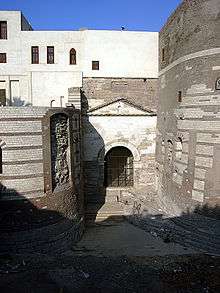Old Cairo
Old Cairo (Arabic: مصر القديمة , Misr al-Qadīma) is a historic area in Cairo, Egypt, which includes the site of a Roman-era fortress and of Islamic-era settlements pre-dating the Fatimid founding of Cairo proper in 969 A.D. It is also considered part of what is referred to as "Historic Cairo", or "Islamic Cairo".
| UNESCO World Heritage Site | |
|---|---|
 Old Cairo, view of Roman gate under the Hanging Church. | |
| Criteria | Cultural: i, ii, iv, v |
| Reference | 89 |
| Inscription | 1979 (3rd session) |
| Area | 52,366 ha |
Description
Old Cairo contains the remnants of those cities which were capitals before al-Qahira, such as Fustat, al-Askar and al-Qatta'i. These are the location of the Mosque of Amr and the Mosque of ibn Tulun, though little else remains today. This area also encompasses Coptic Cairo and its many old churches and ruins of Roman fortifications. Modern tourists visit locations such as the Coptic Museum, the Babylon Fortress, the Hanging Church and other Coptic churches, the Ben Ezra Synagogue and the Mosque of Amr ibn al-As. Fort Babylon is a Roman fortress around which many of the Egyptian Christians' oldest churches were built.

Count Gabriel Habib Sakakini Pasha (1841–1923), who had become a household name in his time, built a palace and a church in the El-Sakakini area in 1897[1] and established the Roman Catholic Cemetery in Old Cairo.[2]
Medieval history
During the latter half of the 15th century, two final major transformations took place in Cairo: the port of Bulaq, and a district called Azbakeya in the northwest section of the city. The perimeters of the city had been unchanged for the past 300 years according to the map done by the French expedition in 1798 AD. With the Barsbay’s conquest of Cyprus in 1428, Bulaq became the major port of Cairo. By the end of the 15th century, Bulaq was even able to take over the role as the major commercial port from Old Cairo.
Conservation and restoration
The effort to conserve Egypt's monuments has existed since the 19th century. In 1881, Khedive Tawfiq founded the Comité de Conservation des Monuments de l'Art Arabe.
In 1979, UNESCO designated Old Cairo, as part of wider Historic Cairo, as a World Heritage Site, calling it "one of the world's oldest Islamic cities, with its famous mosques, madrasas, hammams and fountains" and "the new centre of the Islamic world, reaching its golden age in the 14th century."[3][4]
See also
References
| Wikivoyage has a travel guide for Old Cairo. |
| Wikimedia Commons has media related to Old Cairo. |
- Egy.com Archived 2008-02-25 at the Wayback Machine
- Report on Sakakini Pasha's granddaughter Asma el Bakri
- Centre, UNESCO World Heritage. "Historic Cairo". whc.unesco.org. Retrieved 2018-03-22.
- Antoniou, Jim. "The Conversation of the old City of Cairo" (PDF).